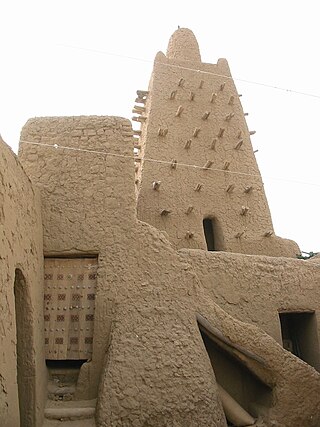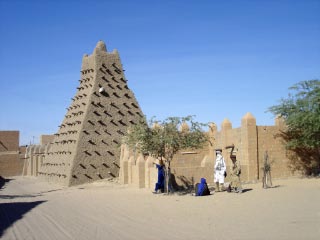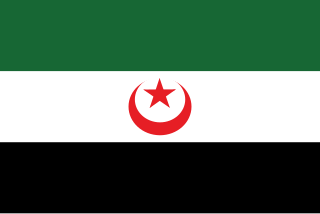Related Research Articles

Timbuktu is a city in Mali, situated twenty kilometres (12 mi) north of the Niger River. The town is the capital of the Tombouctou Region, one of the eight administrative regions of Mali and one town of Songhai people. It had a population of 54,453 in the 2009 census.

Islam is very important to traditional Malian culture. Muslims currently make up approximately 95 percent of the population of Mali. The majority of Muslims in Mali are Malikite Sunni, influenced with Sufism. Ahmadiyya and Shia branches are also present.

Azawad, or Azawagh was a short-lived unrecognised state lasting from 2012 to 2013. Azawagh (Azawaɣ) is the generic Tuareg Berber name of all Tuareg Berber areas, especially the northern half of Mali and northern and western Niger. Its independence was declared unilaterally by the National Movement for the Liberation of Azawad (MNLA) in 2012, after a Tuareg rebellion drove the Malian Army from the region.

The Djinguereber Mosque in Timbuktu, Mali is a famous learning center of Mali built in 1327, and cited as Djingareyber or Djingarey Ber in various languages. Its design is accredited to Abu Ishaq Al Sahili who was paid 200 kg of gold by Musa I of Mali, emperor of the Mali Empire. According to Ibn Khaldun, one of the best known sources for 14th century Mali, al-Sahili was given 12,000 mithkals of gold dust for his designing and building of the djinguereber in Timbuktu. But more reasoned analysis suggests that his role, if any, was quite limited. The architectural crafts in Granada had reached their zenith by the fourteenth century, and it is extremely unlikely that a cultured and wealthy poet would have had anything more than a dilettante's knowledge of the intricacies of contemporary architectural practice.

The Sidi Yahya Mosque, also known as the Mosque of Muhammad-n-Allah, is a mosque and madrasa of Timbuktu in Mali. The construction of the mosque began in 1400 under the leadership of Sheikh el-Mokhtar Hamalla of Timbuktu and was finished in 1440.
Sidi Amar may refer to:

Tourism in Mali is not well developed. Due to issues with infrastructure, tourism had been slow to grow but had seen improvements prior to the 2002 Africa Cup of Nations. However, due to the Northern Mali conflict and threats from terrorism, all major tour operators have withdrawn services which saw a decrease in tourists from 200,000 in 2011 to 10,000 the following year. The nation has four UNESCO World Heritage Sites, including Timbuktu.

The Tuareg Rebellion of 2012 was an early stage of the Mali War; from January to April 2012, a war was waged against the Malian government by rebels with the goal of attaining independence for the northern region of Mali, known as Azawad. It was led by the National Movement for the Liberation of Azawad (MNLA) and was part of a series of insurgencies by traditionally nomadic Tuaregs which date back at least to 1916. The MNLA was formed by former insurgents and a significant number of heavily armed Tuaregs who fought in the Libyan Civil War.

The National Movement for the Liberation of Azawad or the Azawad National Liberation Movement, formerly the National Movement of Azawad, is a political and military organisation based in Azawad in northern Mali.

Ansar Dine (Arabic: أنصار الدين ʾAnṣār ad-Dīn, also transliterated Ançar Deen; meaning "helpers of the religion" also known as Ansar al-Din was a Salafi jihadist group led by Iyad Ag Ghaly. Ansar Dine sought to impose absolute sharia across Mali. The group took over the city of Timbuktu in 2012, which prompted the French-led intervention, Operation Serval.
Iyad Ag Ghaly, also known as Abū al-Faḍl, is a Tuareg militant from Mali's Kidal Region. He has been active in Tuareg rebellions against the Malian government since the 1980s – particularly in the early 1990s. In 1988, founded the Popular Movement for the Liberation of Azawad. In the latest episode of the Tuareg upheavals in 2012, he featured as the founder and leader of the Islamist militant group Ansar Dine.

The Battle of Gao was fought between the National Movement for the Liberation of Azawad (MNLA) and the Islamist Movement for Oneness and Jihad in West Africa (MOJWA), along with its ally Ansar Dine, in Gao between 26–28 June 2012. By the 28 June, Gao, Timbuktu and Kidal, the three biggest cities in the disputed secessionist region of Azawad within what is recognised as Malian territory, were under the control of Ansar Dine and its Islamist allies.

The Mali War is an ongoing armed conflict that started in January 2012 between the northern and southern parts of Mali in Africa. On 16 January 2012, several insurgent groups began fighting a campaign against the Malian government for independence or greater autonomy for northern Mali, which they called Azawad. The National Movement for the Liberation of Azawad (MNLA), an organization fighting to make this area of Mali an independent homeland for the Tuareg people, had taken control of the region by April 2012.

Omar Ould Hamaha was an Islamist militia commander from Northern Mali. During the 2012 Northern Mali conflict he became known alternatively as the spokesman and chief of staff for both Ansar Dine and Movement for Oneness and Jihad in West Africa (MOJWA), militant groups associated with Al-Qaeda in the Islamic Maghreb (AQIM).
Ansar al-Sharia (Mali) is a radical Islamist group that operates in the Azawad region of Mali.

The International Criminal Court investigation in Mali or the Situation in the Republic of Mali is an ongoing investigation by the International Criminal Court (ICC) into war crimes and other crimes within the ICC's jurisdiction that are alleged to have occurred during the Northern Mali conflict since January 2012. The investigation was requested by the government of Mali in July 2012. As the first person who pleaded guilty to a charge of the ICC, al-Mahdi made a statement expressing remorse and advising others not to commit similar acts.

The following is a timeline of major events during the Northern Mali conflict.

The Arab Movement of Azawad is an Arab military organization active in Azawad/northern Mali. Initially known as the National Liberation Front of Azawad, it was formed in early 2012, during the 2012 Tuareg rebellion. The MAA claims to be a secular, non-terrorist organization, whose main objective is to defend the interests of the Arab peoples of northern Mali. It is reportedly willing to "work with France against terrorism, drug trafficking and organized crime" in the region. The group calls for granting substantial autonomy to northern Mali.
Ahmad al-Faqi al-Mahdi was a member of Ansar Dine, a Tuareg Islamist militia in North Africa. Al-Mahdi admitted guilt in the International Criminal Court (ICC) in 2016 for the war crime of attacking religious and historical buildings in the Malian city of Timbuktu. Al-Mahdi was the first person convicted by the ICC for such a crime, and in general the first individual to ever be prosecuted solely on the basis of cultural crimes. He was sentenced to nine years in prison.
The Fall of Timbuktu took place during the war in northern Mali. It was one of the first clashes between the MNLA and Ansar Dine, and led to the latter taking control of the city in June 2012.
References
- ↑ "World Heritage Site in Timbuktu attacked" (News article). AlJazeera. AlJazeera. 7 May 2012. p. English. Retrieved 27 May 2012.
- ↑ "BBC News – Timbuktu shrines damaged by Mali Ansar Dine Islamists". Bbc.co.uk. 30 June 2012. Retrieved 22 October 2012.
- ↑ "333 saints of Timbuktu". Timbuktu. Miranda Dodd. Retrieved 27 May 2012.
- ↑ Rosie Collyer (7 May 2012). "Mali: Islamists Burn World Heritage Site in Timbuktu" (News article). All Africa. AllAfrica. Retrieved 27 May 2012.
- ↑ "World Heritage List: Timbuktu". UNESCO World Heritage Centre. United Nations. Retrieved 27 May 2012.
- ↑ "World Heritage Site in Timbuktu attacked – Africa". Al Jazeera English. Retrieved 22 October 2012.
- ↑ Collyer, Rosie (7 May 2012). "Mali: Islamists Burn World Heritage Site in Timbuktu". allAfrica.com. Retrieved 22 October 2012.
- ↑ "UNESCO concerned about growing threats to cultural heritage in Mali". iNamibia. Retrieved 22 October 2012.
- ↑ "Ansar Dine fighters destroy Timbuktu shrines – Africa". Al Jazeera English. Retrieved 22 October 2012.